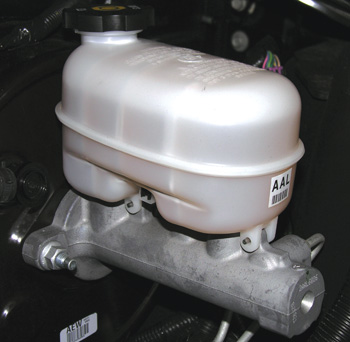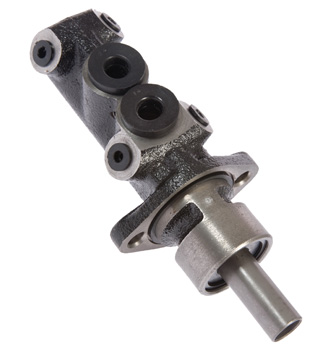Considering that OE stainless steel exhaust systems have drastically reduced replacement intervals and that spark plug and timing belt replacements are scheduled at 100,000 miles or more, brake service is perhaps one of the most lucrative profit centers that the average independent shop has left. 
Consequently, every type of shop, from back alley to specialty franchise, is competing for its share of the brake service market.
Unfortunately, not all of these shops are equally qualified to diagnose and repair brake performance issues involving parts like new master cylinders. As we shall see in the following text, the underlying causes of low or spongy brake pedals normally associated with master cylinders can also be found elsewhere in the system.
Although dealing with warranty complaints can be a touchy business, the position of strength for the counterman is to have good basic working knowledge of how and why brake components like master cylinders fail.
Master Cylinder Configuration
Practically every master cylinder manufactured since 1964 is built in a dual-cylinder, paired brake configuration to provide a margin of safety if the hydraulic system fails. Dual braking systems are built in a front-and-rear paired configuration in which one-half of the master cylinder operates one axle set of brakes.
Dual master cylinders can also be built in a dual-diagonal paired configuration in which one-half of the cylinder operates a left front and right rear brake and the other half the right front and left rear brake. This system provides better vehicle control if a hydraulic failure occurs on one pair of service brakes.
Regardless of the configuration, when one side of the system develops a leak, the brake pedal height is reduced and the brake pedal becomes very spongy. In addition, a red brake warning light is designed to illuminate on the instrument cluster to warn the driver of an unsafe brake condition.
Knowing When To Replace
Unfortunately, master cylinders are often not inspected or replaced when the service brakes are replaced.
Because there are few guidelines on when to replace master cylinders, my own recommendation is to replace a master cylinder in a vehicle that has more than 100,000 miles on the odometer and that is in need of major brake service. It only stands to reason that the master cylinder wears at the same rate as the rest of the hydraulic components in the braking system.
If the vehicle has developed an intermittent loss of brake pedal or an intermittently low brake pedal, the master cylinder is a prime suspect and should be replaced in the interest of safety. This recommendation to replace is reinforced if a heavy accumulation of sludge is present in the master cylinder reservoir.
Master Failure
Because DOT 3 and DOT 4 brake fluids readily absorb moisture from the atmosphere, rust usually forms in the bore of a cast–iron master cylinder. If the master cylinder is used to bleed the brakes or if a leak in the hydraulic system occurs and the brake pedal travels beyond its normal range, the cylinder’s rubber piston seals will scuff as they pass over the rusted bore surface.
Aluminum master cylinders similarly fail when the hardened surface in the cylinder bore chips and the rubber piston seals scuff over the resulting “pothole.”
 As the master cylinder piston seals wear through normal use, they begin to leak pressure inside the cylinder bore. These internal pressure leaks cause the brake pedal to develop a spongy feel or gradually sink to the floor when pedal pressure is maintained on the brake. Worn seals also allow fluid to leak from the open end of the cylinder bore into the vacuum brake booster. If the cylinder intermittently fails to hold pressure or leaks fluid from the rear of the bore, the cylinder should be replaced.
As the master cylinder piston seals wear through normal use, they begin to leak pressure inside the cylinder bore. These internal pressure leaks cause the brake pedal to develop a spongy feel or gradually sink to the floor when pedal pressure is maintained on the brake. Worn seals also allow fluid to leak from the open end of the cylinder bore into the vacuum brake booster. If the cylinder intermittently fails to hold pressure or leaks fluid from the rear of the bore, the cylinder should be replaced.
Pedal Complaints
Many amateur and untrained mechanics often blame a low brake pedal on the recently replaced master cylinder. In general, low brake pedals can be caused by small amounts of air in the hydraulic system or by excess travel in the brake caliper piston caused by a worn wheel bearing. Excess pedal travel also can be caused by worn self-adjusters on drum brakes.
Very small amounts of air tend to accumulate in a brake system over time. In most cases, this condition can be remedied by pressure or vacuum bleeding the brake hydraulics. Vacuum bleeding is generally recommended, especially for vehicles with plastic master cylinder reservoirs and anti-lock braking systems.
If bleeding the system temporarily cures the low pedal complaint, air can be leaking into the system through the copper washers sealing the brake line to the brake caliper or through the caliper piston seal. In rare cases, air can leak into the braking system through the rear seal on the master cylinder piston. Although air leaking into a braking system is a rare condition that’s often difficult to diagnose, it does happen and should never be dismissed as a cause of a low or spongy brake pedal.
The clearance between the brake pad and rotor on a normal disc brake assembly is only a few thousandths of an inch, which is less than the thickness of a piece of notebook paper. If the wheel bearing isn’t adjusted correctly or the bearing is worn, the rotor will tend to force the caliper piston back into its bore. This condition causes a gradually worsening low pedal complaint that can be diagnosed by checking for loose wheel bearings.
Similarly, rusted or broken self-adjusters on rear drum brakes will fail to maintain the small amount of clearance between the brake shoe and the brake drum. Bad rear brake adjusters can be diagnosed by applying the parking brake. If applying the parking brake remedies the low-pedal complaint, the problem lies with the rear brakes. Last, if the vehicle in question is a pickup or SUV that’s been modified for off-road use, the technician should make sure that the brake calipers aren’t contacting a shock absorber mount during a full-lock turn. If contact occurs, the caliper piston will be shoved back into the bore, causing an intermittent loss of brake pedal
complaint.
Tips for Techs
Most master cylinders must be in a level position to allow air bubbles to migrate from the cylinder bore into the cylinder reservoir. Because many master cylinders are mounted in a tilted position that inhibits the migration
of air into the reservoir, the new cylinder should be bench-bled before it’s installed on the vehicle.
Another caution is to compare the new master cylinder with the old to make sure that the pushrod on the power brake booster will seat at the correct height in the new cylinder. When installed, a small amount of clearance should exist between the piston and pushrod to allow the piston to fully retract.
If the pushrod has too much clearance, a low pedal will result. If the pushrod has too little clearance, the service brakes may not release once they’re applied. In addition, the brake light switch that’s normally mounted on the brake pedal should be correctly adjusted to allow the brake pedal to completely release. Most brake switches can easily be adjusted by pulling up on the brake pedal until the pedal rests against its rubber stop pad.
Once the new master cylinder is installed, the brake system should be thoroughly flushed with new fluid to prevent contaminants from finding their way into the new master cylinder. Most vehicles equipped with anti-locking braking systems should use only DOT 3 or DOT 4 brake fluids. The silicone DOT 5 fluids tend to foam, which can cause a low-pedal complaint in an ABS-equipped vehicle.











